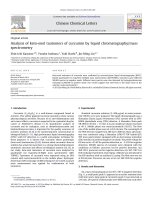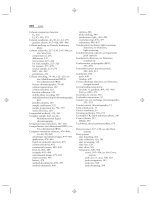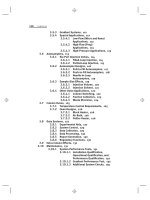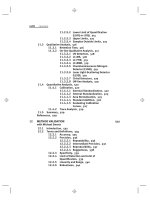liquid chromatography - mass spectrometry an introduction
Bạn đang xem bản rút gọn của tài liệu. Xem và tải ngay bản đầy đủ của tài liệu tại đây (1.82 MB, 288 trang )
LIQUID CHROMATOGRAPHY–
MASS SPECTROMETRY:
AN INTRODUCTION
Liquid Chromatography –Mass Spectrometry: An Introduction. Robert E. Ardrey
Copyright
¶ 2003 John Wiley & Sons, Ltd.
ISBNs: 0-471-49799-1 (HB); 0-471-49801-7 (PB)
Analytical Techniques in the Sciences (AnTS)
Series Editor: David J. Ando, Consultant, Dartford, Kent, UK
A series of open learning/distance learning books which covers all of the major
analytical techniques and their application in the most important areas of physical,
life and materials science.
Titles Available in the Series
Analytical Instrumentation: Performance Characteristics and Quality
Graham Currell, University of the West of England, Bristol, UK
Fundamentals of Electroanalytical Chemistry
Paul M.S. Monk, Manchester Metropolitan University, Manchester, UK
Introduction to Environmental Analysis
Roger N. Reeve, University of Sunderland, UK
Polymer Analysis
Barbara H. Stuart, University of Technology, Sydney, Australia
Chemical Sensors and Biosensors
Brian R. Eggins, University of Ulster at Jordanstown, Northern Ireland, UK
Methods for Environmental Trace Analysis
John R. Dean, Northumbria University, Newcastle, UK
Liquid Chromatography–Mass Spectrometry: An Introduction
Robert E. Ardrey, University of Huddersfield, Huddersfield, UK
Forthcoming Titles
Analysis of Controlled Substances
Michael D. Cole, Anglia Polytechnic University, Cambridge, UK
LIQUID CHROMATOGRAPHY–
MASS SPECTROMETRY:
AN INTRODUCTION
Robert E. Ardrey
University of Huddersfield, Huddersfield, UK
Copyright 2003 John Wiley & Sons Ltd, The Atrium, Southern Gate, Chichester,
West Sussex PO19 8SQ, England
Telephone (+44) 1243 779777
Email (for orders and customer service enquiries):
Visit our Home Page on www.wileyeurope.com or www.wiley.com
All Rights Reserved. No part of this publication may be reproduced, stored in a retrieval system or
transmitted in any form or by any means, electronic, mechanical, photocopying, recording,
scanning or otherwise, except under the terms of the Copyright, Designs and Patents Act 1988 or
under the terms of a licence issued by the Copyright Licensing Agency Ltd, 90 Tottenham Court
Road, London W1T 4LP, UK, without the permission in writing of the Publisher. Requests to the
Publisher should be addressed to the Permissions Department, John Wiley & Sons Ltd, The
Atrium, Southern Gate, Chichester, West Sussex PO19 8SQ, England, or emailed to
, or faxed to (+44) 1243 770620.
This publication is designed to provide accurate and authoritative information in regard to the
subject matter covered. It is sold on the understanding that the Publisher is not engaged in
rendering professional services. If professional advice or other expert assistance is required, the
services of a competent professional should be sought.
Other Wiley Editorial Offices
John Wiley & Sons Inc., 111 River Street, Hoboken, NJ 07030, USA
Jossey-Bass, 989 Market Street, San Francisco, CA 94103-1741, USA
Wiley-VCH Verlag GmbH, Boschstr. 12, D-69469 Weinheim, Germany
John Wiley & Sons Australia Ltd, 33 Park Road, Milton, Queensland 4064, Australia
John Wiley & Sons (Asia) Pte Ltd, 2 Clementi Loop #02-01, Jin Xing Distripark, Singapore 129809
John Wiley & Sons Canada Ltd, 22 Worcester Road, Etobicoke, Ontario, Canada M9W 1L1
Wiley also publishes its books in a variety of electronic formats. Some content that appears
in print may not be available in electronic books.
Library of Congress Cataloging-in-Publication Data
Ardrey,R.E.
Liquid chromatography-mass spectrometry : an introduction / Robert E. Ardrey.
p. cm. – (Analytical techniques in the sciences)
Includes bibliographical references and index.
ISBN 0-471-49799-1 (cloth : alk. paper) – ISBN 0-471-49801-7 (pbk. : alk. paper)
1. Liquid chromatography. 2. Mass spectrometry. I. Title. II. Series.
QP519.9.L55 A73 2003
543
.0894 – dc21 2002028084
British Library Cataloguing in Publication Data
A catalogue record for this book is available from the British Library
ISBN 0-471-49799-1 (Cloth)
ISBN 0-471-49801-7 (Paper)
Typeset in 10/12pt Times by Laserwords Private Limited, Chennai, India
Printed and bound in Great Britain by Antony Rowe Ltd, Chippenham, Wiltshire
This book is printed on acid-free paper responsibly manufactured from sustainable forestry
in which at least two trees are planted for each one used for paper production.
Contents
Series Preface ix
Preface xi
Acknowledgements xiii
Abbreviations, Acronyms and Symbols xv
About the Author xix
1 Introduction 1
1.1 What are the Advantages of Linking High Performance
Liquid Chromatography with Mass Spectrometry? 2
1.2 What Capabilities are Required of the Combination? 3
1.3 What Problems, if Any, Have to be Addressed to Allow
the LC–MS Combination to Function, and Function Effectively? 4
References 5
2 Liquid Chromatography 7
2.1 Introduction 7
2.2 High Performance Liquid Chromatography 10
2.2.1 Pump 10
2.2.2 Sample Introduction (Injector) 11
2.2.3 Mobile Phase 12
2.2.4 Stationary Phase 14
2.2.5 Detectors 16
2.3 Chromatographic Properties 18
2.4 Identification Using High Performance Liquid Chromatography 21
vi Liquid Chromatography–Mass Spectrometry
2.5 Quantitation Using High Performance Liquid Chromatography 23
2.6 The Need for High Performance Liquid Chromatography–
Mass Spectrometry 30
References 31
3 Mass Spectrometry 33
3.1 Introduction 33
3.2 Ionization Methods 36
3.2.1 Electron Ionization 36
3.2.2 Chemical Ionization 36
3.2.3 Fast-Atom Bombardment 38
3.2.4 Matrix-Assisted Laser Desorption Ionization 39
3.2.5 Negative Ionization 40
3.3 Ion Separation 40
3.3.1 The Quadrupole Mass Analyser 41
3.3.2 The (Quadrupole) Ion-Trap Mass Analyser 42
3.3.3 The Double-Focusing and Tri-Sector Mass Analysers 42
3.3.4 The Time-of-Flight Mass Analyser 44
3.4 Tandem Mass Spectrometry (MS–MS) 46
3.4.1 Instrumentation 47
3.4.2 Techniques 51
3.5 Data Acquisition 53
3.5.1 Identification 53
3.5.2 Quantitation 54
3.6 Processing of Mass Spectral Data 58
3.6.1 The Total-Ion-Current Trace 58
3.6.2 Qualitative Analysis 60
3.6.3 Quantitative Analysis 68
3.6.4 The Use of Tandem Mass Spectrometry 71
References 73
4 Interface Technology 75
4.1 Introduction 75
4.2 The Moving-Belt Interface 77
4.3 The Direct-Liquid-Introduction Interface 82
4.4 The Continuous-Flow/Frit
(Dynamic) Fast-Atom-Bombardment Interface 85
4.5 The Particle-Beam Interface 89
4.6 The Thermospray Interface 94
4.7 The Electrospray Interface 98
4.7.1 The Mechanism of Electrospray Ionization 100
4.7.2 Sample Types 105
Contents vii
4.7.3 The Appearance of the Electrospray Spectrum 106
4.7.4 Structural Information from Electrospray Ionization 117
4.8 The Atmospheric-Pressure Chemical Ionization Interface 122
4.8.1 The Mechanism of Atmospheric-Pressure Chemical
Ionization 123
References 126
5 Applications of High Performance Liquid Chromatography–
Mass Spectrometry 129
5.1 Method Development 131
5.1.1 The Use of Experimental Design for Method
Development 133
5.1.2 The Choice of Electrospray or APCI 134
5.2 The Molecular Weight Determination of Biopolymers 141
5.2.1 Electrospray Spectra of Co-Eluting Components 141
5.2.2 The Use of Selected-Ion Monitoring to Examine
the Number of Terminal Galactose Moieties on a
Glycoprotein 143
5.2.3 The Effect of Mobile-Phase Additives and
Cone-Voltage 147
5.3 Structure Determination of Biopolymers 149
5.3.1 Amino Acid Sequencing of Proteins 149
5.3.2 The Use of Enzymes for Amino Acid Sequencing 150
5.3.3 The Mass Spectral Fragmentation of Peptides 152
5.3.4 Confirmation of Amino Acid Sequence Using
the Analysis of LC–MS Data from an Enzyme
Digest of a Protein 152
5.3.5 Determination of the Amino Acid Sequence of a Novel
Protein Using LC–MS Data from an Enzyme Digest 160
5.3.6 Amino Acid Sequencing of Polypeptides
Generated by Enzyme Digestion Using MS –MS 166
5.3.7 The Location of Post-Translational Modifications
Using LC–MS Data from an Enzyme Digest 170
5.3.8 The Location of Post-Translational Modifications
Using MS–MS 173
5.3.9 The Analysis of Polysaccharides Present
in Glycosylated Proteins 177
5.3.10 Location of the Position of Attachment of
a Glycan on the Polypeptide Backbone of a Glycoprotein 181
5.4 Molecular Weight Determination of Small (< 1000 Da)
Molecules 185
5.4.1 The Use of Fast-LC–MS in Combinatorial Chemistry 185
viii Liquid Chromatography–Mass Spectrometry
5.5 Structure Determination of Low-Molecular-Weight
Compounds 189
5.5.1 Method Development for Structural Studies 189
5.5.2 The Use of Target-Compound Analysis and
LC–MS–MS for the Identification of Drug Metabolites 192
5.5.3 The Use of High-Accuracy Mass Measurements
in Combination with LC –MS for the Structure
Determination of Drug Metabolites 199
5.5.4 The Use of Cone-Voltage Fragmentation in Conjunction
with High-Accuracy Mass Measurements and LC–MS
for Metabolite Identification 203
5.5.5 The Use of LC–MS
n
for the Identification
of Drug Metabolites 207
5.6 Quantitation 211
5.6.1 Requirements of a Quantitative Method
Involving LC–MS 211
5.6.2 Quantitative Standardization 213
5.6.3 Matrix Effects in LC–MS 213
5.6.4 The Method of Standard Additions to Overcome
Matrix Effects 218
5.6.5 The Quantitative Determination of DNA
Oxidation Products 222
5.6.6 The Use of MS–MS for Quantitative Determinations 224
References 233
Responses to Self-Assessment Questions 235
Bibliography 241
Glossary of Terms 247
SI Units and Physical Constants 257
Periodic Table 261
Index 263
Series Preface
There has been a rapid expansion in the provision of further education in recent
years, which has brought with it the need to provide more flexible methods of
teaching in order to satisfy the requirements of an increasingly more diverse type
of student. In this respect, the open learning approach has proved to be a valuable
and effective teaching method, in particular for those students who for a variety
of reasons cannot pursue f ull-time traditional courses. As a result, John Wiley
& Sons Ltd first published the Analytical Chemistry by Open Learning (ACOL)
series of textbooks in the late 1980s. This series, which covers all of the major
analytical techniques, rapidly established itself as a valuable teaching resource,
providing a convenient and flexible means of studying for those people who, on
account of their individual circumstances, were not able to take advantage of
more conventional methods of education in this particular subject area.
Following upon the success of the ACOL series, which by its very name is
predominately concerned with Analytical Chemistry,theAnalytical Techniques
in the Sciences (AnTs) series of open learning texts has now been introduced
with the aim of providing a broader coverage of the many areas of science in
which analytical techniques and methods are now increasingly applied. With
this in mind, the AnTs series of texts seeks to provide a range of books which
will cover not only the actual techniques themselves, but also those scientific
disciplines which have a necessary requirement for analytical characterization
methods.
Analytical instrumentation continues to increase in sophistication, and as a
consequence, the range of materials that can now be almost routinely analysed
has increased accordingly. Books in this series which are concerned with the
techniques themselves will reflect such advances in analytical instrumentation,
while at the same time providing full and detailed discussions of the fundamental
concepts and theories of the particular analytical method being considered. Such
books will cover a variety of techniques, including general instrumental analysis,
x Liquid Chromatography–Mass Spectrometry
spectroscopy, chromatography, electrophoresis, tandem techniques, electroana-
lytical methods, X-ray analysis and other significant topics. In a ddition, books in
the series will include the application of analytical techniques in areas such as
environmental science, the life sciences, clinical analysis, f ood science, forensic
analysis, pharmaceutical science, conservation and archaeology, polymer science
and general solid-state materials science.
Written by experts in their own particular fields, the books are presented in
an easy-to-read, user-friendly style, with each chapter including both learning
objectives and summaries of the subject matter being covered. The progress of the
reader can be assessed by the use of frequent self-assessment questions (SAQs)
and discussion questions (DQs), along with their corresponding reinforcing or
remedial responses, which appear regularly throughout the texts. The books are
thus eminently suitable both for self-study applications and for forming the basis
of industrial c ompany in-house training schemes. Each text also contains a large
amount of supplementary material, including bibliographies, lists of acronyms
and abbreviations, and tables of SI Units and important physical constants, plus
where appropriate, glossaries and references to literature sources.
It is therefore hoped that this present series of textbooks will prove to be a
useful and valuable source of teaching material, both for individual students and
for teachers of science courses.
Dave Ando
Dartford, UK
Preface
In this book, I have tried to show the way in which high performance liquid
chromatography–mass spectrometry (LC–MS) has developed, somewhat slowly
it has to be said, into a powerful hybrid analytical technique.
In the first chapter, I have discussed the limitations of high performance liquid
chromatography (HPLC) and mass spectrometry when used in isolation and how
the combination of the two allows these to be overcome. In this chapter, the
effect of combining the two techniques with regard to the individual performance
characteristics are explored.
In Chapters 2 and 3, brief descriptions of HPLC and MS are provided. These
are not fully comprehensive but are intended to provide a brief description of
those aspects of each of the techniques which are pertinent to a consideration of
LC–MS.
Seven different LC–MS interfaces are described in Chapter 4, with particular
emphasis being placed on their advantages and disadvantages and the ways in
which the interface overcomes (or fails to overcome) the incompatibilities of the
two techniques. The earlier interfaces are included for historical reasons only
as, for example, the moving-belt and direct-liquid-introduction interfaces, are not
currently in routine use. The final chapter (Chapter 5) is devoted to a number of
illustrative examples of the way in which LC–MS has been used to solve various
analytical problems.
I have tried to make it clear that the LC–MS combination is usually more
powerful that either of the individual techniques in isolation and that a holistic
approach must be taken to the development of methodologies to provide data
from which the required analytical information may be obtained. Data analysis is
of crucial importance in this respect and for this reason the computer processing
of LC–MS data is considered in some detail in both Chapters 3 and 5.
LC–MS is still not used in many laboratories where it would be a cost-effective
investment. In order that interested readers can gauge whether they should ‘test
xii Liquid Chromatography–Mass Spectrometry
the water’, a number of applications which illustrate the range of analyses and
the analytical performance that may be obtained from modern LC–MS interfaces
have been described. Although your precise application may not appear here, I
hope that the descriptions are general enough for the reader to draw parallels
with their own work.
Bob Ardrey
University of Huddersfield, UK
Acknowledgements
I gratefully acknowledge the assistance of the following, without whom this book
would not have been completed.
My colleagues Lindsay Harding (mass spectroscopist), Carl Hall (analytical sci-
entist) and Terry Pearson (chromatographer) from the Department of Chemical
and B iological Sciences at The University of Huddersfield for helpful discus-
sions and their criticisms and suggestions made during the writing of the book.
Their combined expertise has hopefully meant that the text is appropriate for its
intended audience and that the author has not assumed too much prior knowl-
edge on the part of the reader. Their painstaking checking of the manuscript (on
a number of occasions) is gratefully recorded. In particular, I must acknowledge
the part that Terry Pearson has played in my retaining the little sanity I have as
Huddersfield Town FC, our joint passion, have experienced more ‘downs’ than
‘ups’ in recent years! I wish him well in his retirement.
Dave Ando, from John Wiley & Sons Ltd, for his constant encouragement from
the time of our initial discussions through to copy-editing and proof-reading of
the final manuscript, and the hours spent discussing the state of English cricket
and the ‘downs’ a nd ‘ups’ (in that order) of Manchester City FC, the latter being
his passion, not mine!
Micromass, the mass spectrometry company, for permission to use their tech-
nical literature and application notes and, in particular, Chris Herbert for helpful
discussions and access to his c omputer graphics.
Finally, but not least, my wife, Lesley, for her forbearance and support while
the preparation of this book has taken up the majority of my time.
Abbreviations, Acronyms
and Symbols
Ala alanine
APCI atmospheric-pressure chemical ionization
Arg arginine
AS aerospray
Asn asparagine
Asp aspartic acid
BPI base peak intensity
CI chemical ionization
CID collision-induced dissociation
CNL constant neutral loss
CVF cone-voltage fragmentation
Cys cysteine
Da dalton (atomic mass unit)
DC direct current
DLI direct-liquid introduction
EI electron ionization
EPA Environmental Protection Agency (USA)
ESA electrostatic analyser
ESI electrospray ionization
eV electronvolt
FAB fast-atom bombardment
Fuc fucose (a deoxy sugar)
Gal galactose
GalNAc N-acetylgalactosamine
GC gas chromatography
xvi Liquid Chromatography–Mass Spectrometry
GC–MS gas chromatography – in combination with mass
spectrometry
GlcNAc N-acetylglucosamine
Gln glutamine
Glu glutamic acid
Gly glycine
Hex hexose (a monosaccharide with six carbon atoms)
HexNAc N-acetylhexosamine
His histidine
HIV human immunodeficiency virus
HPLC high performance liquid chromatography
i.d. internal diameter
Ile isoleucine
IS internal standard
IUPAC International Union of Pure and Applied Chemistry
kV kilovolt
LC liquid chromatography
LC–FTIR (high performance) liquid chromatography in
combination with Fourier-transform infrared
(spectroscopy)
LC–MS (high performance) liquid chromatography in
combination with mass spectrometry
LC–MS–MS (high performance) liquid chromatography in
combination with tandem mass spectrometry
LC–ToF-MS (high performance) liquid chromatography in
combination with time-of-flight mass spectrometry
Leu leucine
LOD limit of detection
LOQ limit of quantitation
Lys lysine
(M −H)
−
deprotonated molecular ion
(M +H)
+
protonated molecular ion
MAGIC monodisperse aerosol generating interface for
chromatography
MALDI matrix-assisted laser desorption ionization
MALDI–ToF matrix-assisted laser desorption ionization with a
time-of-flight mass analyser
max ent maximum entropy
Met methionine
MID multiple-ion detection
MIKES mass-analysed ion kinetic energy spectrometry
MRM multiple-reaction monitoring
MS mass spectrometry
Abbreviations, Acronyms and Symbols xvii
MS–MS mass spectrometry in combination with mass
spectrometry (tandem mass spectrometry)
MS
n
multiple stages of tandem mass spectrometry
NIH National Institute of Health (USA)
NIST National Institute of Standards and Technology
(USA)
o.d. outside diameter
ODS octadecyl silyl stationary phase used in high
performance liquid chromatography
PAGE polyacrylamide gel electrophoresis
Phe phenylalanine
Pro proline
PSD post-source decay
QC quality control
Q-ToF quadrupole time-of-flight mass analyser
Q-ToF–LC–MS–MS quadrupole time-of-flight mass analyser in
combination with (high performance)
liquid chromatography and tandem mass
spectrometry
RF radiofrequency
RIC reconstructed ion chromatogram
RMM relative molecular mass
RSD relative standard deviation
S/N signal-to-noise ratio
SDM selected-decomposition monitoring
SD standard deviation
SDS–PAGE sodium dodecyl sulfate–polyacrylamide gel
electrophoresis
Ser serine
SIM selected-ion monitoring
SIR selected-ion recording
SRM selected-reaction monitoring
TFA trifluoroacetic acid
Thr threonine
TIC total-ion current
ToF time-of-flight
Trp tryptophan
TSP thermospray
Tyr tyrosine
UV ultraviolet
V volt
vol/vol volume by volume
Val valine
xviii Liquid Chromatography–Mass Spectrometry
B magnetic field (magnitude)
CV coefficient of variation
E electrostatic analyser voltage
H chromatographic plate height
k
capacity factor (in high performance liquid
chromatography)
L length of chromatographic column
m/z mass-to-charge ratio
MW molecular weight
N number of theoretical plates for a chromatographic
column
R resolution – chromatographic or mass spectral;
correlation coefficient
R
2
coefficient of determination
RE relative error
t
0
retention time of non-retained component in high
performance liquid chromatography (dead time)
t
an
retention time of a nalyte
w chromatographic peak width
α chromatographic selectivity
λ
max
wavelength of maximum absorption in a UV spectrum
About the Author
Robert E. Ardrey, B .Sc., Ph.D.
Bob Ardrey obtained a first degree in Chemistry from the University of Surrey
where he went on to obtain his doctorate studying the chemistry of trans-
2,3-dichloro-1,4-dioxan and the stereochemistry of its reaction products using
primarily mass spectrometry and nuclear magnetic resonance spectroscopy. He
then carried out post-doctoral research at King’s College, London, into the devel-
opment of emitters for field-desorption mass spectrometry.
He then joined the Central Research Establishment of the Home Office Forensic
Science Service (as it then was) at Aldermaston where he developed thermo-
gravimetry–MS, pyrolysis-MS, GC–MS and LC–MS methodologies for the
identification of analytes associated with crime investigations. It was here that
his interest in LC–MS began with the use of an early moving-belt interface.
This interest continued during periods of employment with two manufacturers
of LC–MS equipment, namely Kratos and subsequently Interion, the UK arm of
the Vestec Corporation of H ouston, Texas, the company set up by Marvin Vestal,
the primary developer of the thermospray LC–MS interface.
In 1990, Bob set up a mass spectrometry consultancy which he ran until
becoming a Senior Lecturer in Analytical Chemistry within the Department of
Chemical and Biological Sciences at the University of Huddersfield.
Bob is particularly concerned that, although analytical chemistry forms a major
part of the UK chemical industry’s efforts, it is still not considered by many to
be a subject worthy of special consideration. Consequently, experimental design
is often not employed when it should be and safeguards to ensure accuracy
and precision of analytical measurements are often lacking. He would argue that
although the terms accuracy and precision can be defined by rote, their meanings,
when applied to analytical measurements, a re not appreciated by many members
of the scientific community.
He is therefore pleased to be associated with this series, which he hopes will
help to address this problem.
Chapter 1
Introduction
Learning Objectives
• To understand the need to interface liquid chromatography and mass
spectrometry.
• To understand the requirements of an interface between liquid chromatog-
raphy and mass spectrometry and the performance of the combined system.
The combination of chromatography and mass spectrometry (MS) is a subject
that has attracted much interest over the last forty years or so. The combina-
tion of gas chromatography (GC) with mass spectrometry (GC–MS) was first
reported in 1958 and made available commercially in 1967. Since then, it has
become increasingly utilized and is probably the most widely used ‘hyphenated’
or ‘tandem’ technique, as such combinations are often known. The acceptance
of GC–MS as a routine technique has in no small part been due to the fact that
interfaces have been available for both packed and capillary columns which allow
the vast majority of compounds amenable to separation by gas chromatography
to be transferred efficiently to the mass spectrometer. Compounds amenable to
analysis by GC need to be both volatile, at the temperatures used to achieve
separation, and thermally stable, i.e. the same requirements needed to produce
mass spectra from an analyte using either electron (EI) or chemical ionization
(CI) (see Chapter 3). In simple terms, therefore, virtually all compounds that pass
through a GC column can be ionized and the full analytical capabilities of the
mass spectrometer utilized.
This is not the case when high performance liquid chromatography (HPLC) and
MS are considered where, due to the incompatibilities of the two techniques, they
cannot be linked directly and an interface must be used, with its prime purpose
being the removal of the chromatographic mobile phase. Unfortunately, no single
Liquid Chromatography –Mass Spectrometry: An Introduction. Robert E. Ardrey
Copyright
¶ 2003 John Wiley & Sons, Ltd.
ISBNs: 0-471-49799-1 (HB); 0-471-49801-7 (PB)
2 Liquid Chromatography–Mass Spectrometry
interface exists which possesses similar capabilities to those available for GC-MS,
i.e. one that will allow mass spectra to be obtained from any compound that
elutes from an HPLC column, and thus LC–MS has not been guaranteed to
provide the required analytical information. In addition, the complexity of the
mass spectrometer has meant that the majority of chromatographers have not had
direct access to the instrumentation and have had to rely on a service facility
to provide results. They were therefore unable to react rapidly to the results
of an analysis and consequently found it a particularly inconvenient detector
to contemplate using. The different interfaces that have been made available
commercially, and the applications to which they have been put, are the subjects
of the following chapters.
Before discussing these in detail, it is appropriate to consider a number of
general questions, namely:
(1) What are the advantages of linking HPLC with mass spectrometry?
(2) What capabilities are required of such a combination?
(3) What problems, if any, have to be addressed to allow the combination to
function, and function effectively?
1.1 What are the Advantages of Linking High
Performance Liquid Chromatography
with Mass Spectrometry?
In order to answer the first question, the limitations of the individual techniques
must be considered and whether the combination will allow all or some of these
to be overcome. Before doing this, however, the analytical tasks to which the
combination will be applied must be defined.
In many analyses, the compound(s) of interest are found as part of a complex
mixture and the role of the chromatographic technique is to provide separation
of the components of that mixture to allow their identification or quantitative
determination. From a qualitative perspective, the main limitation of chromatog-
raphy in isolation is its inability to provide an unequivocal identification of the
components of a mixture even if they can be completely separated from each
other. Identification is based on the comparison of the retention characteristics,
simplistically the retention time, of an unknown with those of reference materials
determined under identical experimental conditions. There are, however, so many
compounds in existence that even if the retention characteristics of an unknown
and a reference material are, within the limits of experimental error, identical, the
analyst cannot say with absolute certainty that the two compounds are the same.
Despite a range of chromatographic conditions being available to the analyst, it
is not always possible to effect complete separation of all of the components of a
mixture and this may prevent the precise and accurate quantitative determination
of the analyte(s) of interest.
Introduction 3
The power of mass spectrometry lies in the fact that the mass spectra of
many compounds are sufficiently specific to allow their identification with a high
degree of confidence, if not with complete certainty. If the analyte of interest
is encountered as part of a mixture, however, the mass spectrum obtained will
contain ions from all of the compounds present and, particularly if the analyte of
interest is a minor component of that mixture, identification with any degree of
certainty is made much more difficult, if not impossible. The combination of the
separation capability of chromatography to allow ‘pure’ compounds to be intro-
duced into the mass spectrometer with the identification capability of the mass
spectrometer is clearly therefore advantageous, particularly as many compounds
with similar or identical retention characteristics have quite different mass spectra
and can therefore be differentiated. This extra specificity allows quantitation to
be carried out which, with chromatography alone, would not be possible.
The combination of HPLC with mass spectrometry therefore allows more
definitive identification and the quantitative determination of compounds that
are not fully resolved chromatographically.
1.2 What Capabilities are Required
of the Combination?
Ideally, the capabilities of both instruments should be unaffected by their being
linked. These include the following (adapted from Snyder and Kirkland [1]):
• The interface should cause no reduction in chromatographic performance. This
is particularly important for the analysis of complex multi-component mixtures
(although the specificity of the mass spectrometer may, in certain circum-
stances, compensate for some loss of performance – see Chapter 3).
• No uncontrolled chemical modification of the analyte should occur during its pas-
sage through the interface or during its introduction into the mass spectrometer.
• There should be high sample transfer to the mass spectrometer or, if this takes
place in the interface, ionization efficiency. This is of particular importance
when trace-level components are of interest or when polar and/or labile analytes
are involved.
• The interface should give low chemical background, thus minimizing possible
interference with the analytes.
• The interface should be reliable and easy to use.
• The interface should be simple and inexpensive (a subjective assessment).
• Operation of the interface should be compatible with all chromatographic con-
ditions which are likely to be encountered, including flow rates from around
20 nl min
−1
to around 2 ml min
−1
, solvent systems from 100% organic phase
to 100% aqueous phase, gradient elution, which is of particular importance in
4 Liquid Chromatography–Mass Spectrometry
the biological field in which mixtures covering a wide range of polarities are
often encountered, and buffers, both volatile and involatile.
• Operation of the interface should not compromise the vacuum requirements of
the mass spectrometer and should allow all capabilities of the mass spectrom-
eter to be utilized, i.e. ionization modes, high resolution, etc.
• The mass spectrum produced should provide unambiguous molecular weight
information from the wide range of compounds amenable to analysis by HPLC,
including biomolecules with molecular weights in excess of 1000 Da. The
study of these types of molecule by mass spectrometry may be subject to
limitations associated with their ionization and detection and the mass range
of the instrument being used.
• The mass spectrometer should provide structural information that should be
reproducible, interpretable and amenable to library matching. Ideally, an elec-
tron ionization (EI) (see Chapter 3) spectrum should be generated. An interface
that fulfils both this requirement and/or the production of molecular weight
information, immediately lends itself to use as a more convenient alternative
to the conventional solid-sample insertion probe of the mass spectrometer and
some of the interfaces which have been developed have been used in this way.
• The interface should provide quantitative information with a reproducibility
better than 10% with low limits of detection and have a linear response over
a wide range of sample sizes (low picograms to µg).
1.3 What Problems, if Any, Have to be Addressed
to Allow the LC–MS Combination to Function,
and Function Effectively?
It is possible to carry out a chromatographic separation, collect all, or selected,
fractions and then, after removal of the majority of the volatile solvent, transfer
the analyte to the mass spectrometer by using the conventional inlet (probe)
for solid analytes. The direct coupling of the two techniques is advantageous in
many respects, including the speed of analysis, the convenience, particularly for
the analysis of multi-component mixtures, the reduced possibility of sample loss,
the ability to carry out accurate quantitation using isotopically labelled internal
standards, and the ability to carry out certain tasks, such as the evaluation of
peak purity, which would not otherwise be possible.
There are two major incompatibilities between HPLC and MS. The first is
that the HPLC mobile phase is a liquid, often containing a significant proportion
of water, which is pumped through the stationary phase (column) at a flow
rate of typically 1 ml min
−1
, while the mass spectrometer operates at a pressure
of around 10
−6
torr (1.333 22 × 10
−4
Pa). It is therefore not possible simply
to pump the eluate from an HPLC column directly into the source of a mass
Introduction 5
spectrometer and an important function of any interface is the removal of all,
or a significant portion, of the mobile phase. The second is that the majority of
analytes that are likely to be separated by HPLC are relatively involatile and/or
thermally labile and therefore not amenable to ionization by using either EI or
CI. Alternative ionization methods have therefore to be developed.
In the following chapters, the basic principles of HPLC and MS, in as far as
they relate to the LC–MS combination, will be discussed and seven of the most
important types of interface which have been made available commercially will be
considered. Particular attention will be paid to the electrospray and atmospheric-
pressure chemical ionization interfaces as these are the ones most widely used
today. The use of LC –MS for identification and quantitation will be described
and appropriate applications will be discussed.
Summary
In this chapter, the reader has been introduced to the analytical advantages to be
gained by linking high performance liquid chromatography to mass spectrometry
with particular regard to the limitations of the two techniques when they are used
independently.
The characteristics of an ideal liquid chromatography–mass spectrometry inter-
face have been discussed, with emphasis having been placed upon the major
incompatibilities of the two component techniques that need to be overcome to
allow the combination to function effectively.
References
1. Snyder, L. R. and Kirkland, J. J., Introduction to Modern Liquid Chromatography, Wiley, New
York, 1974.
Chapter 2
Liquid Chromatography
Learning Objectives
• To understand those aspects of high performance liquid chromatography
which are essential to the application of LC –MS.
2.1 Introduction
The International Union of Pure and Applied Chemistry (IUPAC) defines chro-
matography as follows [1]:
‘Chromatography is a physical method of separation in which the components
to be separated are distributed between two phases, one of which is stationary
(the stationary phase), while the other (the mobile phase) moves in a definite
direction. A mobile phase is described as “a fluid which percolates through or
along the stationary bed in a definite direction”. It may be a liquid, a gas or a
supercritical fluid, while the stationary phase may be a solid, a gel or a liquid.
If a liquid, it may be distributed on a solid, which may or may not contribute
to the separation process.’
A chromatographic system may be considered to consist of four component
parts, as follows:
• a device for sample introduction
• a mobile phase
• a stationary phase
• adetector
Liquid Chromatography –Mass Spectrometry: An Introduction. Robert E. Ardrey
Copyright
¶ 2003 John Wiley & Sons, Ltd.
ISBNs: 0-471-49799-1 (HB); 0-471-49801-7 (PB)
8 Liquid Chromatography–Mass Spectrometry
A number of different chromatographic techniques are in use and these differ
in the form of these four components and their relative importance. For example,
in gas chromatography the injector used for sample introduction is of paramount
importance and must be chosen in light of the properties of the analytes under
investigation (their stability and volatility) and the amount of the analytes present.
An incorrect choice could prevent a successful analysis. In high performance liq-
uid chromatography (HPLC) the injector is simply required to allow introduction
of the analytes into a flowing liquid stream without introducing any discrimination
effects and a single type, the loop injector, is used almost exclusively.
The two components which are associated with the separation that occurs in a
chromatographic system are the mobile and stationary phases.
In HPLC, the mobile phase is a liquid delivered under high pressure (up
to 400 bar (4 × 10
7
Pa)) to ensure a constant flow rate, and thus reproducible
chromatography, while the stationary phase is packed into a column capable of
withstanding the high pressures which are necessary.
A chromatographic separation occurs if the components of a mixture interact
to different extents with the mobile and/or stationary phases and therefore take
different times to move from the position of sample introduction to the position
at which they are detected. There are two extremes, as follows:
(i) All analytes have total affinity for the mobile phase and do not interact with
the stationary phase – all analytes move at the same rate as the mobile phase,
they reach the detector very quickly and are not separated.
(ii) All analytes have total affinity for the stationary phase and do not interact
with the mobile phase – all analytes are retained on the column and do not
reach the detector.
The role of the chromatographer is therefore, based on a knowledge of the
analytes under investigation, to manipulate the properties of the stationary and/or
mobile phases to move from these extremes and effect the desired separation.
A number of detectors may be used in conjunction with HPLC (see Section
2.2.5 below), with the type chosen being determined by the type of analysis, i.e.
qualitative or quantitative, being undertaken. The requirements for each of these
are often quite different, as described in the following:
• Qualitative (identification) applications depend upon the comparison of the
retention characteristics of the unknown with those of reference materials. In
the case of gas chromatography, this characteristic is known as the retention
index and, although collections of data on ‘popular’ stationary phases exist, it
is unlikely that any compound has a unique retention index and unequivocal
identification can be effected. In liquid chromatography, the situation is more
complex because there is a much larger number of combinations of stationary
and mobile phases in use, and large collections of retention characteristics on
any single ‘system’ do not exist. In addition, HPLC is a less efficient separation
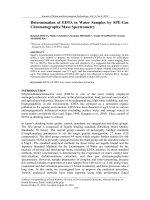
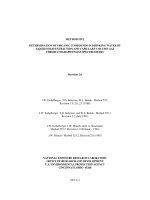
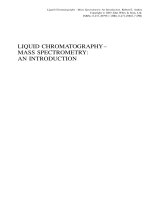
![niessen - liquid chromatography - mass spectrometry 3e [lcms] (crc, 2006)](https://media.store123doc.com/images/document/14/ne/ea/medium_eaq1401870789.jpg)

